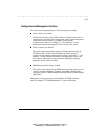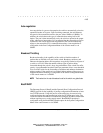
. . . . . . . . . . . . . . . . . . . . . . . . . . . . . .
1-15
Compaq SW3322/SW3323/SW3324 Dual-Speed Switch User Guide
Writer: Fran Spragens Project: Overview Comments: 355307-002
File Name:3324_1.doc Last Saved On:3/16/99 11:31 AM
Class of Service
Class of Service support allows you to assign a higher priority to selected traffic
passing through the switch. The switches support Class of Service attributes per
the IEEE802.1D/D5 (previously known as IEEE 802.1p) standard specification
using a priority queuing mechanism. This feature ensures that traffic during
congestion periods will not interfere with traffic assigned a higher priority.
Traffic assigned a lower priority is subject to discard when memory is in short
supply. See Appendix D, “Class of Service,” for more information about this
feature.
Application Examples
The exploding popularity of the Internet and of corporate intranets, as well as
new, high-bandwidth desktop applications, are driving the demand for Fast
Ethernet. The increase in multimedia traffic and the need to support legacy
protocols alongside new, data intensive applications is driving the need for
network segmentation and traffic prioritization.
The SW3322/SW3323/SW3324 switch is ideal for meeting the needs of today’s
high performance networks. Their low cost and high port count make them
affordable for dedicated 10/100Mb/s connections to the desktop. And their
extensive features, including VLAN capability, provide the management
needed for the workgroup and local backbone.
The following sections illustrate the switches employed in two examples:
n Client/Server Network
n Local Backbone
Client/Server Network Application
To improve workstation performance in a client/server environment, the switches
can be configured to provide 200 Mb/s full duplex Fast Ethernet connections to
servers by connecting each to a dedicated switch port (Figure 1-5). Users can be
accommodated through connections to hubs, both at 10Mb/s and 100Mb/s speeds,
through 10Mb/s switches with 100Mb/s uplinks, or through direct connections.
The fiber uplinks can connect the switch to the corporate backbone, which may be
located on another floor or building.


















